Citizen Action as a Driving Force of Change. The Meninas of Canido, Art in the Street as an Urban Dynamizer
Abstract
1. Introduction
2. Objectives and Method
- Analyze the extent to which cultural initiatives promoted by citizens are able to regenerate degraded spaces and increase the feeling of empowerment and identity of its inhabitants.
- Check to what extent these initiatives, which have arisen as popular resilience events, remain as such over the years, or if they have changed with respect to their beginnings.
- Know the perception that the inhabitants of the affected neighborhoods have towards such cultural initiatives and what their future prospects are.
3. The Paradigm Shift in Urban Policies
- Local administrations were aware of their degree of indebtedness derived from the construction of megaprojects and saw their budgets cut because debt forgiveness was a priority for the central government.
- Citizens demanded a new way of creating a city and recovering the right to the city and real democracy. According to Harvey [30], in Spain, the clamor for the right to the city meant insisting on the right to change and reinvent the city based on the wishes of the people who inhabit it. In this context, civil society took to the streets, following demonstrations and the emergence of citizen platforms from which the new leftist parties emerged that would arrive in the 2015 elections to the municipal governments of cities such as Madrid, Barcelona, Cádiz, A Coruña, Santiago de Compostela, and Ferrol. Some parties promised their citizens the defense of democratic rights, an end to corruption, a restoration of the well-being of citizens, a guarantee true democracy, and service to the vulnerable population [31,32,33,34].
4. Citizen Movements and Social Innovation: Two Key Factors for the Recovery of Neighborhoods
- Innovative actions related to the different phases of the economic cycle (production, distribution, financing, or consumption). Among them, we can differentiate those of a formal and informal nature, from cooperatives and associations to organic produce consumer groups, where intermediaries are eliminated, or to projects such as social currency or barter markets. In this field, the population has mobilized looking for an alternative economy from which ethical banking or crowd funding are born. Financial alternatives to the existing ones, where the maximum benefit is not sought, are able to carry out projects thanks to the collaboration and cooperation of different agents. This group also includes actions such as time banks, in which participants exchange their skills for time instead of money, where hours are added when a service is provided to another participant and subtracted when you are the beneficiary of the service.
- Social innovation actions linked to participatory processes from which ideas are collected to carry out some urban interventions in the neighborhood. In this case, we want to highlight the Los Madriles project (Figure 1), started in 2015, which consists of an atlas of collectively generated neighborhood initiatives. Its objective is to generate a network between the different projects that are underway in Madrid and that share a social vision and community intervention. This initiative stands out for the diversity of promoters who managed to put the website into operation: the Federation of Neighborhood Associations of Madrid (FRAVM), Zuloark, the citizen initiatives incubator, all for praxis and Transversal Landscape collectives, social and neighborhood groups, and Intermediae, an experimental space devoted to socially engaged artistic practices approached from the angle of research and cultural innovation.
- Social innovation actions linked to the urban environment of the neighborhood, carrying out projects in the public space. In some cases, they are projects related to the environment—promoting more sustainable forms of access and use of resources - and the revitalization or recovery of the physical space, which will subsequently have a social impact. Self-management spaces that are developed in the public space and real estate. This group highlights the initiatives of urban gardens (Figure 2), small plots in which agricultural tasks are carried out with ecological farming methods, where the productive functions associated with family consumption are combined with social and environmental and which house a potential to develop activities of citizen participation. Its success has been so great that the number of urban gardens exceeds 15,000, in more than 300 municipalities. Among the initiatives aimed at recovering empty and degraded urban spaces, we can mention This is not a site in Zaragoza (Figure 2). It consists of the recovery of abandoned plots within the city, where a process of cleaning, rehabilitation, and maintenance makes them open spaces for neighbors. This results in the removal of abandoned spaces in urban and unused areas where rubbish usually accumulates. Empty plots are converted into public spaces, creating gardens, parks, or urban vegetable gardens among others.
- Social innovation action is linked to arts and creativity because culture can be the growth factor at the source of economic competitiveness and can also contribute to the social development and environmental sustainability of neighborhoods [56]. In this group, urban murals and paintings stand out. Artistic expressions are made in public space—buildings, facades, streets, and squares—with the aim of improving their image and recovering them not only from a physical point of view but also a social and economic one. In this sense, we must consider that some street art initiatives have resulted in urban regeneration, gentrification and tourism processes. However, while at first they can be valued positively since they revitalize the neighborhood, in the medium term, they can result in expulsion processes of the population due to the rise in housing and commercial real estate prices and the negative effects of mass tourism in specific urban sectors.
5. The Urban Recovery of Degraded Neighborhoods: The Effect of Street Art.
6. Street Art in the Canido Neighborhood: The Recovery of a Historically Stigmatized Neighborhood in the City of Ferrol
6.1. Las Meninas de Canido: the Art of the Museum on the Street
- The city council wanted to show its support for the initiative by providing funds for the purchase of material, although its contribution is not enough.
- The number of participants increased. While Eduardo Hermida initially called well-known artists to join him, there are currently many artists requesting to participate in the event.
- Artistic techniques and activities (short films, poetry, dance, games for children, etc.) have been expanded.
- The modality of large murals has been introduced to hide the ugliness of the large medians in the urban landscape of the neighborhood. Among the stand-out murals are the contemporary interpretations of Las Meninas by artist Shfir, with the unmasked Menina (Figure 5), or the work of Lily Brik with a Menina tribute to the Infanta Margarita (Figure 5).
- If at the beginning they were only painted on the walls of abandoned homes, now it is the owners of the houses and the catering businesses that request that the Meninas be painted on their walls or streets. Likewise, homeowners who have been affected by rehabilitation processes that have occasionally deteriorated or destroyed the paintings on them, are requesting that their Meninas be restored.
6.2. The Impact of Meninas in the Neighborhood of Canido
- The neighbors of Canido feel prouder than ever of their neighborhood and have reinforced a degree of identity with it. In the past, Canido was considered by the population of Ferrol as a degraded neighborhood, in which all the industries and amenities that “bothered people” (cemetery, factories, etc.) were historically located, where the working population was concentrated, and an whose residents were contrary to the regime of the dictator. No one wanted to live or say they lived in it.
- Canido has become a trendy neighborhood, which some people say resembles London’s Soho. It is one of the most desired spaces in the city to live. It has become a different neighborhood: vital, enthusiastic, optimistic. It is a reconstructed neighborhood in which art itself is the identifying element and a tourist attraction. People want to live in the neighborhood, and this is how it has gone from having about 1300 inhabitants in 2008 to 7500 in 2018. The rise in land prices is another complement. While before you could buy a plot of land for less than €20,000, now, there is nothing below €150,000.
- It is currently an urban sector in which institutions are focusing their interest, understanding that the Meninas de Canido is an event that favors tourist activity, which was previously practically nonexistent in the city. Murals have become a focus of attraction for people who visit it (Figure 8). Everyday there is someone who walks the streets with a camera to take a picture of the murals. It is estimated that about 50,000 people visit the neighborhood every year in order to see Las Meninas.
- This momentum has also been supported by municipal urban renewal initiatives to provide it with more livable spaces: functional squares, benches, trees, or larger sidewalks are elements that improve livability. In some of them, Las Meninas are part of their urban furniture.
- Rehabilitation projects of some homes are being carried out in the key points of the neighborhood. Rehabilitations are mostly carried out by residents of the neighborhood with liberal professions and enough purchasing power to cover the cost of refurbishment and renovation. Without a doubt, it is the best way to keep residents and attract new ones.
- In the last five years, 27 businesses have opened. Hospitality and traditional commerce have noticed a revival in the neighborhood. The owners of traditional commerce affirm that this revitalization has allowed them to stay open and to have some stability. For its part, the hospitality sector acknowledges it has benefited and seen its bottom line improve, not only on the days when the Meninas are celebrated but also during the rest of the year, thanks to the activities being promoted since becoming a civic center of the neighborhood.
7. Conclusions
- How to manage/control the processes of gentrification, elitization, and tourism that can be registered in neighborhoods where street art is successful in order to preserve the harmony of the neighborhood and avoid as far as possible the expulsion of its residents.
- What situations are conducive to the success of street art, and what is the degree of dependence on this activity. Could there be a reversal of the dynamic process that these neighborhoods undergo if these artistic competitions end? Will the neighborhood still have the same social and economic strength?
- If we start from the fact that street art contests arise in most cases at the initiative of some artists or groups of citizens, with the support of the administrations, the future of the neighborhood should be designed together between all parties, promoting complementary actions that strengthen the quality of life of residents in the neighborhood and consolidate their economic and social revitalization in the medium term.
Author Contributions
Funding
Conflicts of Interest
References
- Eizaguirre, S.; Pradel, M.; Terrones, A.; Martinez-Celorrio, X.; García, M. Multilevel governance and social cohesion: Bringing back conflict in citizenship practices. Urban Stud. 2012, 49, 1999–2016. [Google Scholar] [CrossRef]
- García-Cabeza, M.S. State-led real estate boosterism and the breakdown of the Spanish urban model. In Debating the Neo-Liberal City, 1st ed.; Pinson, G., Morel-Journel, C., Eds.; Routledge: London, UK, 2017; pp. 174–187. [Google Scholar]
- Del Romero-Renau, L.; Valera-Lozano, A. From NIMBYsm to the 15M: A decade of urban conflicts in Barcelona and Valencia. Territ. Politics Gov. 2016, 4, 375–395. [Google Scholar] [CrossRef]
- Koutrolikou, P. Governmentalities of urban crises in inner-city Athens, Greece. Antipode 2016, 48, 172–192. [Google Scholar] [CrossRef]
- Vale, M. Economic crisis and the Southern European regions: Towards alternative territorial development policies. In Identity and Territorial Character. Re-Interpreting Local-Spatial Development, 1st ed.; Salom, J., Farinós, J., Eds.; Universidad de Valencia: Valencia, Spain, 2014; pp. 37–48. [Google Scholar]
- Fernández Maíllo, G. VIII Informe Sobre Exclusión y Desarrollo Social en España; Fundación Foessa: Madrid, Spain, 2019. [Google Scholar]
- Mínguez, C.; Piñeira, M.J.; Fernández-Tabales, A. Social Vulnerability and Touristification of Historic Centers. Sustainability 2019, 11, 4478. [Google Scholar] [CrossRef]
- Méndez, R.; Abad, L.D.; Echaves, C. Atlas de la Crisis. Impactos Socioeconómicos y Territorios Vulnerables en España; Tirant lo Blanch: Valencia, Spain, 2015. [Google Scholar]
- Piñeira, M.J.; Trillo, J.M. The effect of the crisis on vulnerable neighbourhoods: An approximation of the Spanish context through a case study (A Coruña, Galicia). In Crisis, Globalization and Social and Regional Imbalances in Spain; Spanish Commitee IGU: Madrid, Spain, 2016; pp. 136–148. [Google Scholar]
- Piñeira, M.J.; Durán, F.R.; Taboada, J. Urban Vulnerability in Spanish Medium-Sized Cities during the Post-Crisis Period (2009–2016). The Cases of a Coruña and Vigo (Spain). Urban Sci. 2018, 2, 37. [Google Scholar] [CrossRef]
- Alguacil, J.; Camacho, J.; Hernández, A. La vulnerabilidad urbana en España. Identificación y evolución de los barrios vulnerables. Empiria. Rev. Metodol. Cienc. Soc. 2014, 27, 73–94. [Google Scholar] [CrossRef]
- Nel.lo, O. Transform the City with Citizenship. Criteria and Reflections for the Barrio. Plan of Barcelona; Ayuntamiento de Barcelona: Barcelona, Spain, 2017. [Google Scholar]
- Hernández, A.; Matesanz, A.; García, C.; Alguacil, J.; Camacho, J.; Fernández, C. Atlas de Barrios Vulnerables de España: 12 Ciudades 1991/2001/2006; Instituto Juan de Herrera: Madrid, Spain, 2015. [Google Scholar]
- Wehrhahn, R. Contentious urban housing politics in European metropolises between financialisation, dispossession and re-possession: Jahrbuch StadtRegion. In Housing and Housing Politics in European Metropolises; Wehrhahn, R., Pohlan, J., Hannemann, C., Othengrafen, F., Schmidt-Lauber, B., Eds.; Springer: Wiesbaden, Germany, 2019; pp. 3–20. [Google Scholar]
- Koutrolikou, P. Changing landscapes of urban citizenship: Southern Europe in times of crisis. Citizsh. Stud. 2017, 21, 379–392. [Google Scholar]
- Heernan, E.; McHale, J.; Moore-Cherry, N. Debating Austerity in Ireland: Crisis, Experience and Recovery; Royal Irish Academy: Dublin, Ireland, 2017. [Google Scholar]
- Janoschka, M. Who Loses and Who Wins in a Housing Crisis? Lessons from Spain and Greece for a Nuanced Understanding of Dispossession. Hous. Policy Debate 2017, 28, 117–134. [Google Scholar]
- Blanco, A.; Blázquez, M.; Canoves, G. Barcelona, Housing Rent Bubble in a Tourist City. Social Responses and Local Policies. Sustainability 2018, 10, 2043. [Google Scholar] [CrossRef]
- Blanco, A.; Subirats, J. Políticas urbanas en España: Dinámicas de transformación y retos ante la crisis. Geopolítica(s) 2012, 3, 15–33. [Google Scholar]
- Pradel Miquel, M.; García Cabeza, M. El Momento de la Ciudadanía: Innovación Social y Gobernanza Urbana; Catarata: Barcelona, Spain, 2018. [Google Scholar]
- Burriel de Orueta, E. La década prodigiosa del urbanismo español (1997–2006). Scr. Nova Rev. Electrón. Geogr. Cienc. Soc. 2008, 12, 64. [Google Scholar]
- Lois González, R.C.; Piñeira Mantiñán, M.J. Urban development processes in Spain—From consolidated cities to urban regions with an over densified housing market. In Contemporary Problems of Urban and Regional Development; Mierzejewsa, L., Wdowicka, M., Eds.; Bogucki: Poznan, Poland, 2011; pp. 61–71. [Google Scholar]
- Rullan Salamanca, O. Urbanismo expansivo en el Estado Español: De la utopía a la realidad. In Geografía y Desafíos Territoriales en el Siglo XXI.; Gozálvez, V., Marco, J.A., Eds.; Asociación de Geógrafos Españoles & Universidad de Alicante: Alicante, Spain, 2012; pp. 165–209. [Google Scholar]
- De Gregorio Hurtado, S. El desarollo de las iniciativas comunitarias Urban y Urban II en las periferias degradadas de las ciudades españolas. Una contribución a la práctica de la regeneración urbana en España. Ciudades 2010, 13, 39–59. [Google Scholar]
- Ministry of Development. URBACT Program. Available online: www.rediniciativasurbanas.es/convocatoria-de-ayudas/urbact (accessed on 3 January 2020).
- Ministry of Development. Integrated and Sustainable Urban Development Strategy. Available online: www.rediniciativasurbanas.es/convocatoria-de-ayudas/estrategias-dusi (accessed on 3 January 2020).
- Casagrande, M. Urban Acupuncture. Available online: http://thirdgenerationcity.pbworks.com/f/urban%20acupuncture.pdf (accessed on 3 January 2020).
- Alcalá Agulló, F.; Jménez Sánchez, F. Los Costes Económicos del Déficit de Calidad Institucional y la Corrupción en ESPAÑA; Fundación BBVA: Bilbao, Spain, 2018. [Google Scholar]
- Center for Sociological Research. Three Main Problems That Currently Exist in Spain (Multi-Response%) (2007–2019). Available online: www.cis.es/cis/export/sites/default/-Archivos/Indicadores/documentos_html/TresProblemas.html (accessed on 3 January 2020).
- Harvey, D. Ciudades Rebeldes. del Derecho de la Ciudad a la Revolución Urbana; Akal: Madrid, Spain, 2012. [Google Scholar] [CrossRef]
- Ekers, M.; Hamel, P.; Keil, R. Governing suburbia: Modalities and mechanisms of suburban governance. Reg. Stud. 2012, 46, 405–422. [Google Scholar] [CrossRef]
- McLeod, G. Urban politics reconsidered: Growth machine to post-democratic city. Urban Stud. 2011, 48, 2629–2660. [Google Scholar] [CrossRef]
- Romero, J.; Farinós, J. Redescubriendo la gobernanza más allá del buen gobierno. Democracia como base, desarrollo territorial como resultado. Boletín Asoc. Geógrafos Españoles 2011, 56, 295–319. [Google Scholar]
- Swyngedouw, E. Governance innovation and the citizen: The Janus face of governance-beyond-the-state. Urban Stud. 2005, 42, 1991–2006. [Google Scholar] [CrossRef]
- Peck, J.; Theodore, N.; Brenner, N. Neoliberalism resurgent? Market rule after the great recession. South Atl. Q. 2012, 111, 265–288. [Google Scholar] [CrossRef]
- Storper, M. Keys to the City. How Economics, Institutions, Social Interaction and Politics Shape Development; Princeton University Press: Oxford, UK, 2013. [Google Scholar]
- Lois, R.; Macía, C.; Piñeira, M.J.; Calvo, A. Smart cities and regions in Europe. In Life in a Changing Urban Landscape; Kotze, N., Donaldson, R., Visser, G., Eds.; University of Johannesburg: Johannesburg, South Africa, 2014; pp. 27–36. [Google Scholar]
- European Commission. Local and Regional Partners Contributing to Europe 2020: Multi-Level Governance in Support of Europe 2020; European Commission: Brussels, Belgium, 2015. [Google Scholar]
- Hatfield, S.; Nelson, R.; Cook, D. Adaptive Governance: An Introduction and Implications for Public Policy; Australian Agricultural and Resource Economics Society: Queenstown, Ireland, 2007. [Google Scholar]
- Howlett, M.; Ramesh, M. Three orders of governance failure: Policy capacity, problem context and design mismatches. In Proceedings of the 23rd World Congress (Challenges of Contemporary Governance), Montreal, QC, Canada, 20–25 July 2014; IPSA: Montreal, QC, Canada, 2014. [Google Scholar]
- Steurer, R. Disentangling governance: A synoptic view of regulation by government, business and civil society. Policy Sci. 2013, 46, 387–410. [Google Scholar] [CrossRef]
- Cabreirizo, C.; Klett, A.; García, P. De alianzas anómalas a nuevos paisajes políticos. Madrid, Lavapiés y otras geografías de lo común. Urbs. Rev. Estud. Urbanos Cienc. Soc. 2014, 5, 163–178. [Google Scholar]
- Allmendiger, P.; Haughton, G. Spatial planning, devolution, and new planning spaces. Environ. Plan. Gov. Policy 2010, 28, 803–818. [Google Scholar] [CrossRef]
- Méndez, R. Crisis económica, vulnerabilidad urbana y desempleo en España. Ciudad Territ. Estud. Territ. 2013, 178, 649–667. [Google Scholar]
- Stocker, G.; Wilson, D. British Local Government: An Assessment of Labour’s Reform Programme; Palgrave Macmillan: Basingstoke, UK, 2004. [Google Scholar]
- Harvey, D. De la gestión al empresarialismo: La transformación de la gobernanza urbana en el capitalismo tardío. In Espacios de Capital, Hacia una Geografía Crítica; Harvey, D., Piña, C., Eds.; Akal: Madrid, Spain, 2007. [Google Scholar]
- Lois, R.; Piñeira, M.J.; Vives, S. The urban bubble process in Spain: An interpretation from the theory of circuits of capital. J. Urban Reg. Anal. 2016, 8, 5–20. [Google Scholar]
- Lois, R.C.; Piñeira, M.J. The revival of urban social and neighbourhood movements in Spain: A geographical characterization. DIE ERDE 2015, 146, 127–138. [Google Scholar]
- Delgado Jiménez, A. De la participación ciudadana a la gobernanza urbana: Transformaciones políticas y territoriales. Ciudad. Para Futuro Más Sosten. Boletín Cf+S 2009, 44, 67–78. [Google Scholar]
- Newman, J. Remaking Governance: Peoples, Politics and the Public Sphere; Policy Press: Bristol, UK, 2005. [Google Scholar]
- Durán Villa, F.R.; Piñeira Mantiñán, M.J. Evictions and the social crisis in Spanish cities. In Urban Challenges in a Complex World: Resilience, Governance and Changing Urban; Moore-Cherry, N., Ed.; University College Dublin & IGU: Dublin, Ireland, 2015; pp. 80–85. [Google Scholar]
- Valiño, V. Emergencia Habitacional en el Estado Español: La Crisis de las Ejecuciones Hipotecarias y Los Desalojos Desde una Perspectiva de Derechos Humanos; Observatorio OESC, PAH: Barcelona, Spain, 2013. [Google Scholar]
- Moulaert, F.; Martinelli, F.; Swyngedouw, E.; Gonzalez, S. Towards alternative model(s) of local innovation. Urban Stud. 2005, 42, 1969–1990. [Google Scholar] [CrossRef]
- Murray, R.; Mulgan, G.; Caulier, J. How to Innovate: The Tools for Social Innovation; The Young Foundation and Nesta: London, UK, 2011. [Google Scholar]
- Blanco, I.; Cruz, H.; Martínez, R.; Parès, M. El papel de la innovación social frente a la crisis. Ciudad Territ. 2016, 48, 49–260. [Google Scholar]
- Sacco, P.L.; Ferilli, G. Il Distretto Culturale Evoluto Nell’economia Post Industriale; DADI, Università IUAV: Venezia, Italy, 2006. [Google Scholar]
- Arte Urbano. Available online: www.significados.com/arte-urbano/ (accessed on 3 December 2019).
- Ballaz, X. El graffiti como herramienta social. Una mirada psicosocial a las potencialidades críticas del arte urbano. In Violencia y Salud Mental Salud Mental y Violencias Institucional, Estructural, Social y Colectiva; Markez Alonso, I., Fernández Liria, A., Perez-Sales, P., Eds.; A.E.N Estudios: Madrid, Spain, 2009; pp. 131–144. [Google Scholar]
- Allende, S. Street Art. Catálogo de la Exposición Arte Urbano de la Calle al Museo; Consejería de Cultura y Portavocía; Comunidad Autónoma de la Región de Murcia: Murcia, Spain, 2017. [Google Scholar]
- Visconti, L.M.; Sherry, J.F.; Borghini, S.; Anderson, L. Street art, sweet art? Reclaiming the “Public” in public place. J. Consum. Res. 2010, 37, 511–529. [Google Scholar] [CrossRef]
- Loeffler, S. City as Skin: Urban Imaginaries of Flesh and Fantasy. Archit. Des. 2013, 83, 114–119. [Google Scholar] [CrossRef]
- Molina, G.; Guinard, P. Arts in Cities–Cities in Arts. Artic. J. Urban Res. 2017, 15. [Google Scholar]
- Baudrillard, J. Le Système des Objets; Éditions Gallimard: Paris, France, 1968. [Google Scholar]
- Tornaghi, C. Questioning the Social Aims of Public Art in Urban Regeneration Initiatives. The Case of Newcastle upon Tyne and Gateshead (UK); University of Milano-Bicocca: Milan, Italy, 2008. [Google Scholar]
- Gómez Aguilera, F. Arte, Ciudadanía y Espacio Público. W@Terfront 2004, 5, 36–51. [Google Scholar]
- The Bushwick Collective. Available online: https://artsandculture.google.com/exhibit/gRPwr3J5 (accessed on 5 November 2019).
- Wynwood Walls. Available online: www.thewynwoodwalls.com/overview (accessed on 5 November 2019).
- Ramil, E.; Llorca, G.; Rodríguez, J.A. Historia de Ferrol; Via Lactea: La Coruña, Spain, 1998. [Google Scholar]
- Pérez, S. Gabriel Vázquez Seijas. Memoria de Vida. Salamanca; Gráficas Lope: Salamanca, Spain, 2001; pp. 393–414. [Google Scholar]
- Kapstein, P. Vulnerabilidad y Periferia Interior. Cuad. Investig. Urban. 2010, 71, 7–114. [Google Scholar]
- Madoz, P. Galicia. Diccionario Madoz; Breogán: Santiago de Compostela, Spain, 1986; Volume 3, pp. 537–538. [Google Scholar]
- Montero, J. Historia y Descripción de El Ferrol; Gersan: Puentedeume, Spain, 1986; pp. 203–204. [Google Scholar]
- Abeconsa Prepares to Launch Its Great Promotion in Canido. Available online: www.lavozdegalicia.es/noticia/ferrol/2019/09/14/abeconsa-prepara-lanzar-gran-promocion-canido/0003_201909F14C2992.htm (accessed on 5 November 2019).
- Galician Institute of Statistics. Available online: www.ige.eu/estatico/estat.jsp?ruta=html/gl/PanoramaConcellos/02_Poboacion.html (accessed on 5 November 2019).
- Canido Will Receive the Award on Wednesday for Being Considered the Best Neighborhood in Galicia. Available online: www.diariodeferrol.com/articulo/ferrol/canido-recibira-miercoles-galardon-ser-considerado-mejor-barrio-galicia/20190610000218258368.html (accessed on 5 November 2019).
- Castells, M. Globalización e Identidad. Quad. Mediterr. 2010, 14, 254–262. [Google Scholar]
- The Neighborhood of Canido Is Once Again Pulled with Its Market. Available online: www.lavozdegalicia.es/noticia/ferrol/ferrol/2019/09/10/barrio-canido-vuelve-tener-tiron-mercado/0003_201909F10C12991.htm (accessed on 5 November 2019).
- A Market That Took the Urban Garden to Canido. Available online: www.lavozdegalicia.es/noticia/ferrol/2013/09/21/mercado-llevo-huerta-canido/00031379775449214304300.htm (accessed on 5 November 2019).
- The Art of Mercalegre Was Completed in This Edition with Music and Theater. Available online: www.diariodeferrol.com/articulo/ferrol/arte-mercalegre-completo-edicion-musica-teatro/20180708224309230793.html (accessed on 5 November 2019).
- The Route of the Canido Meninas in Ferrol (with Banksy?). Available online: https://saltaconmigo.com/blog/2017/09/ruta-de-las-meninas-canido-ferrol-banksy/ (accessed on 5 November 2019).
- Forte, F.; De Paola, P. How Can Street Art Have Economic Value? Sustainability 2019, 11, 580. [Google Scholar] [CrossRef]

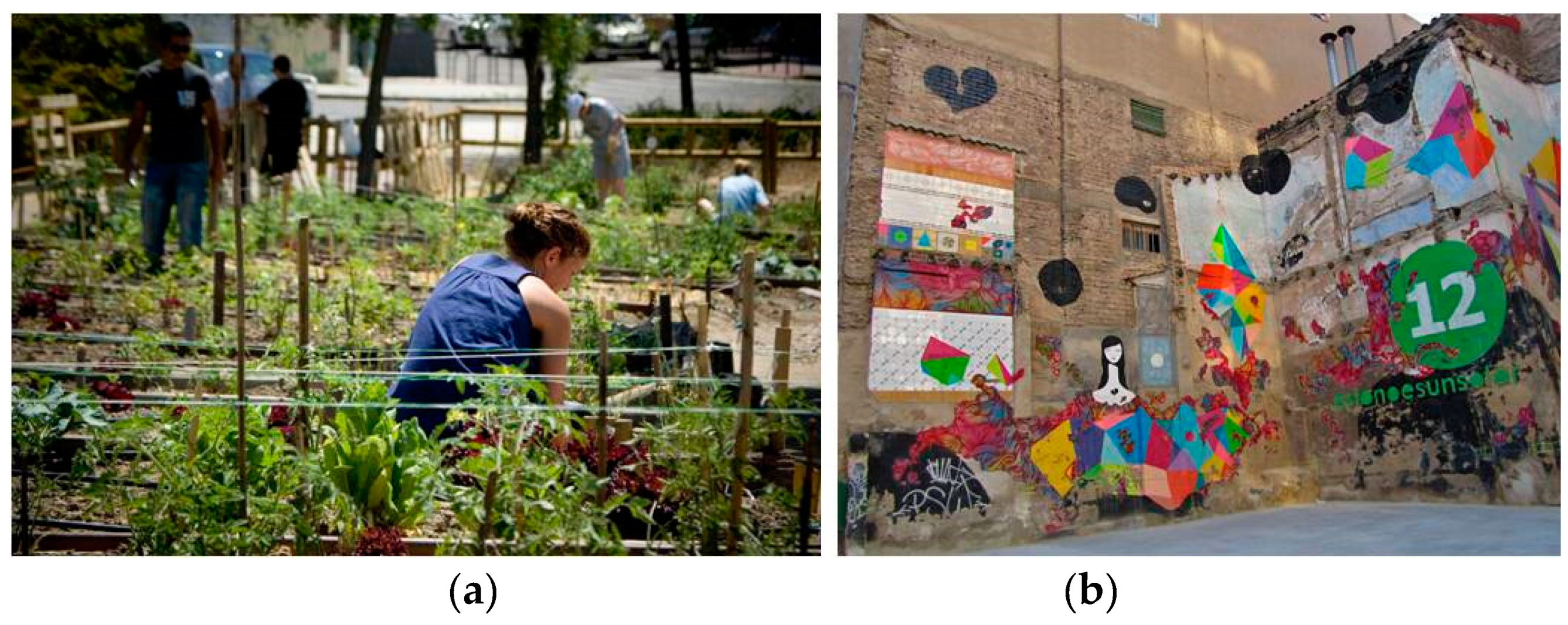

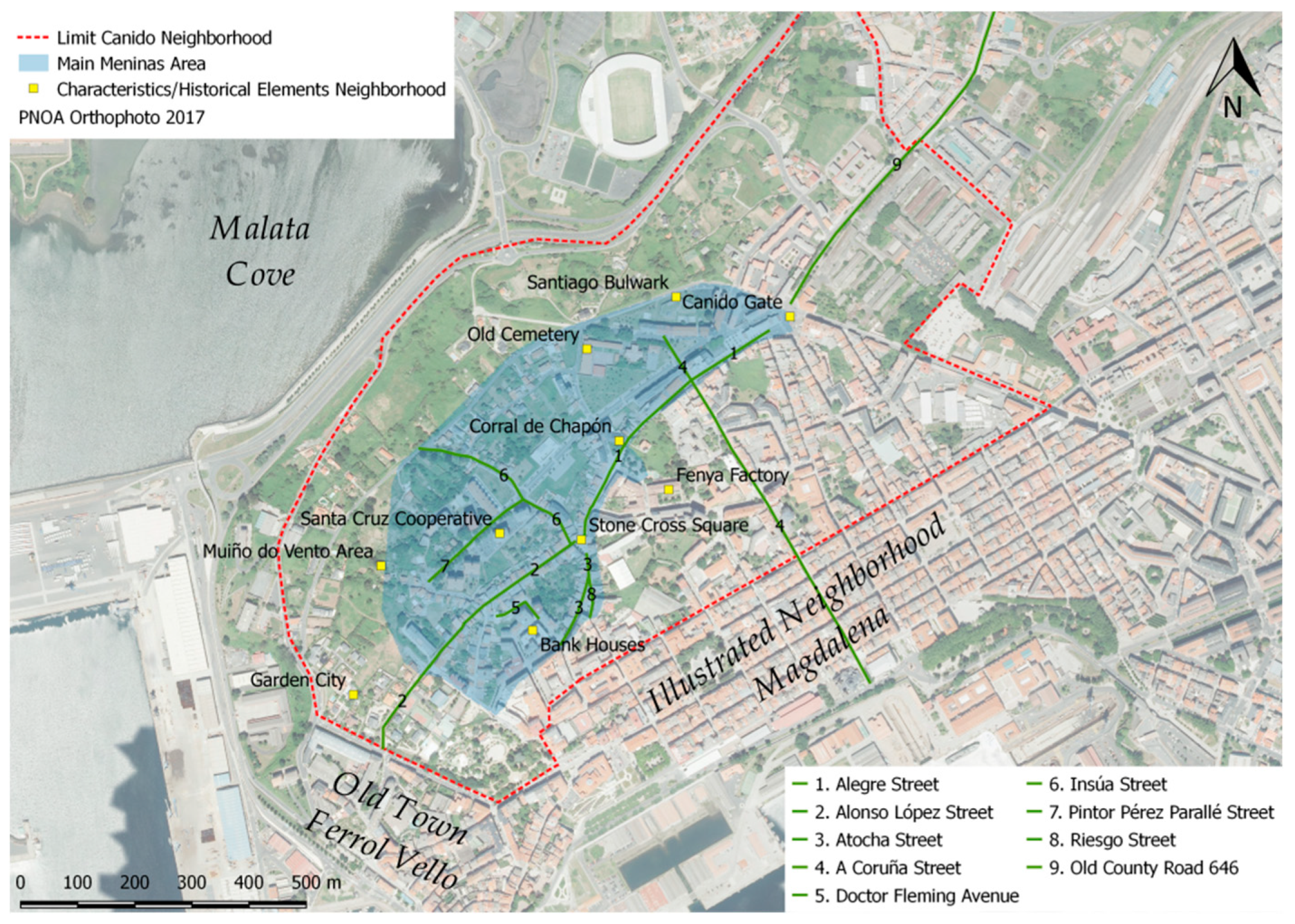
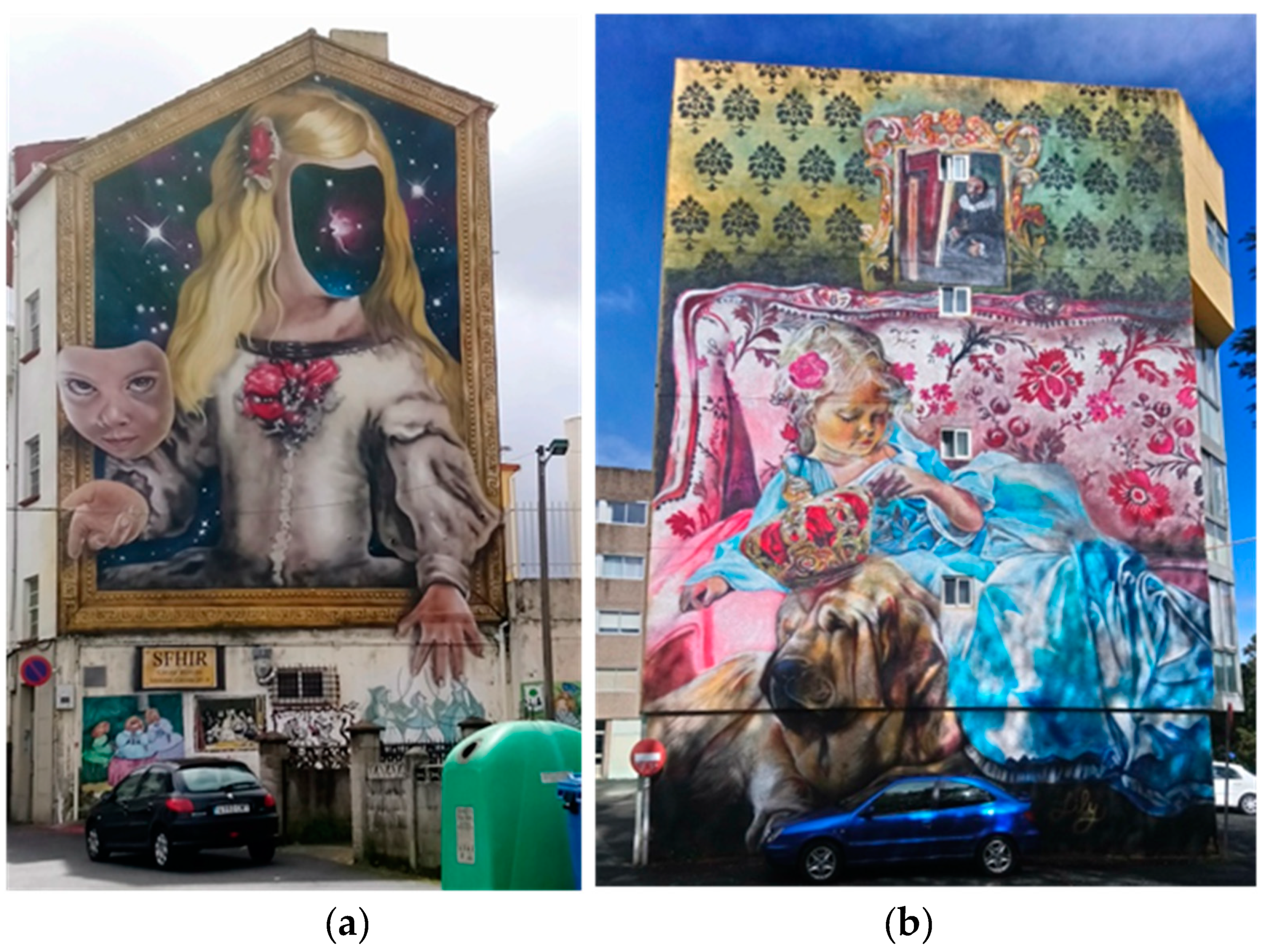
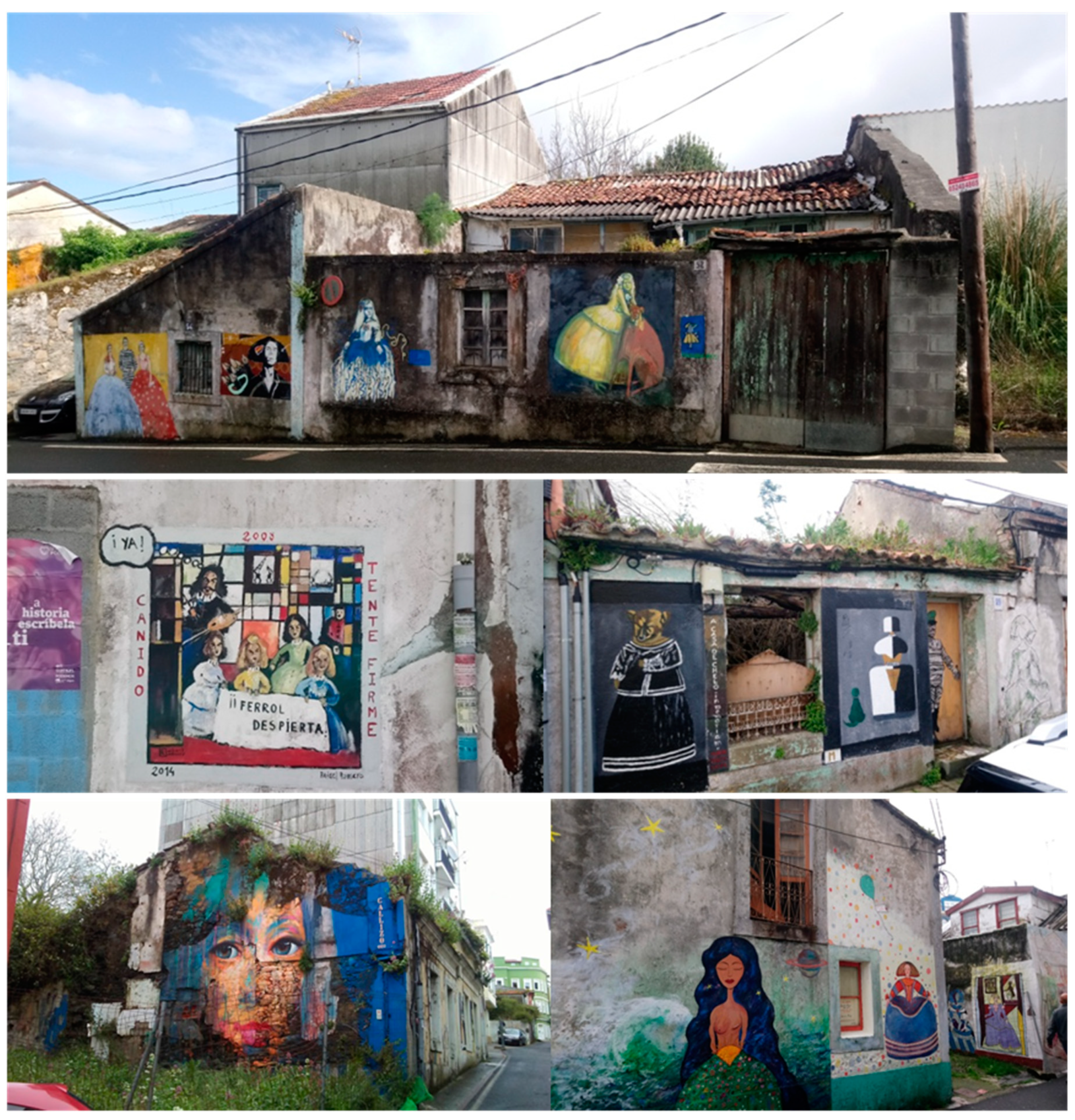

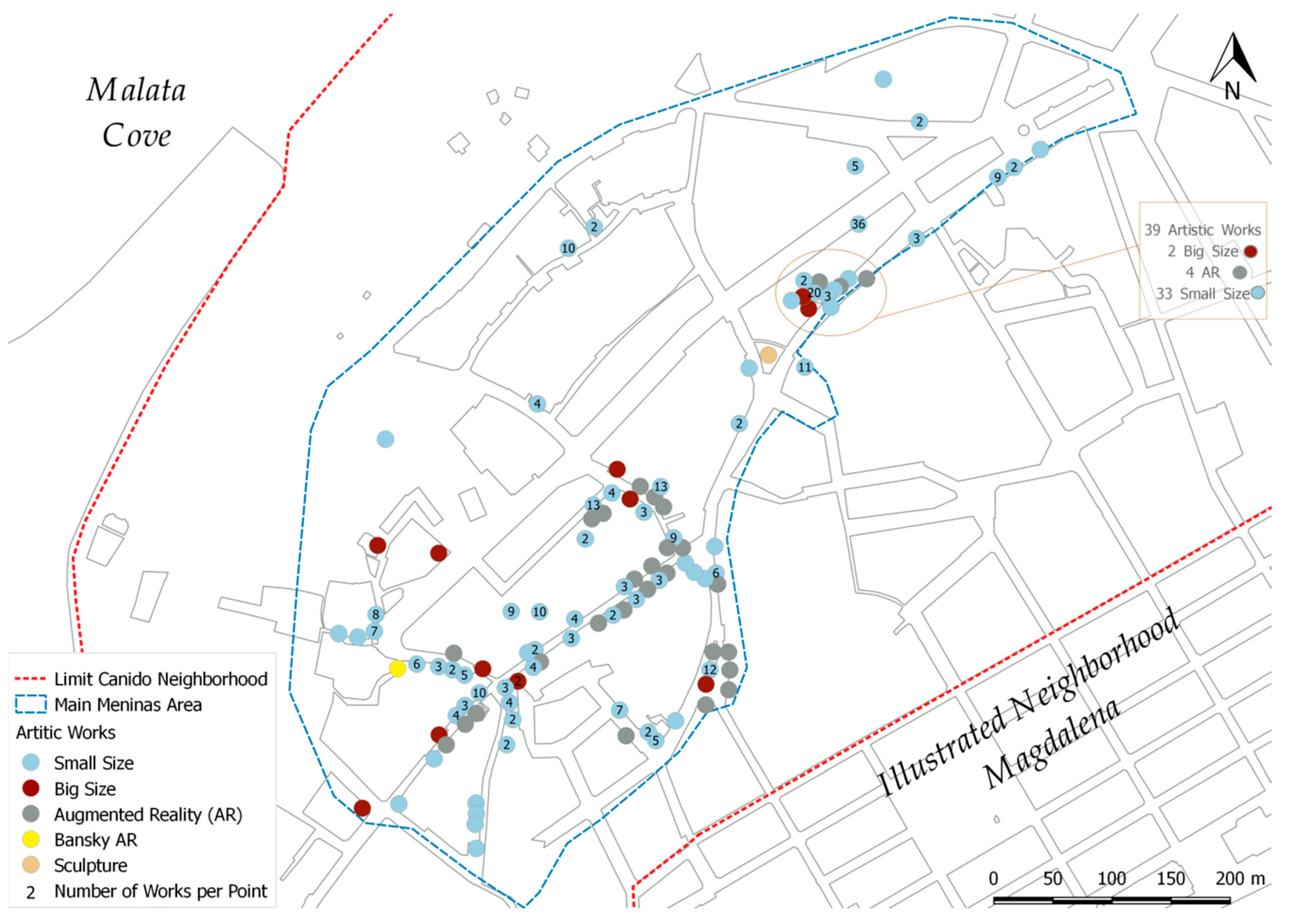
| Las Meninas Block | Neighborhood Block |
|---|---|
| How did the idea come about? Who participates? In what areas are Las Meninas painted? How are the areas to be painted organized (more degraded, continuity with the previous ones)? Is the popular character of the event maintained? To what extent have the Meninas de Canido promoted the city of Ferrol and the neighborhood of Canido? To what extent does the city council participate (financial contribution, services, etc.)? What will happen when there are no walls left to paint? How many artists and works are there? | Has the identity of the neighborhood been reinforced thanks to Las Meninas? Have Las Meninas been the true driving force of the neighborhood? Have you favored the opening of new businesses? To what extent have they influenced urban regeneration processes? Can gentrification processes associated with the rehabilitation and sale of homes be observed? Have prices increased? What new projects are there for the neighborhood? |
| Key Elements | 1990–2007 | 2008–2019 |
|---|---|---|
| Model of urban governance | Creating a modern and competitive city image Efficiency was established by private sector measures Contingent on the market [22,23] Top-down control of power and decision-making [19] | City: a space to live and a place for citizens [35] Restoring the role of the state [27] Multilevel governance that incorporates social action [36] Restoring democratic values [37,38,39] Need for a new economic order Bottom-up decision-making and a new institutional structure [40] |
| Urban planning | Subjecting planning to market interests [41,42] Builders define urban development [43] Administration has a secondary role Land liberalization and building at all costs [23] Deregulation of urban and spatial planning [23] Lack of coordination between urban policies [19] | Establishment of urban planning criteria to halt deregulation [44] Administration plays a leading role in planning [23] Encouraging participation in neighborhoods Interaction in actors’ network [45] Realistic budgets that conform to actual needs Focusing investments on vulnerable neighborhoods |
| Focus of interest | Entrepreneurial city [46] Construction of housing, installation and infrastructure megaprojects [47] Urban sprawl and metropolitan spaces | Promotion of social and economic innovations Development of dynamic projects Overcoming social, economic and housing insecurity Citizen mobility [48] Cities being resilient and alternative (ways of being resilient, having alternative economies) spaces [8] Right to the city Right to housing |
| Key players | Banks, financial institution and the administration [23] | The administration Empowered citizens [49,50] |
| Results | Overextended growth of cities and metropolitan areas Loss of value in cities City becoming a product Dismantling of the welfare state [9,51,52] | Planning of model cities Understanding the city as a whole Value of neighborhoods Priority for the well-being of citizens Greater quality of life |
© 2020 by the authors. Licensee MDPI, Basel, Switzerland. This article is an open access article distributed under the terms and conditions of the Creative Commons Attribution (CC BY) license (http://creativecommons.org/licenses/by/4.0/).
Share and Cite
Piñeira Mantiñán, M.J.; Durán Villa, F.R.; López Rodríguez, R. Citizen Action as a Driving Force of Change. The Meninas of Canido, Art in the Street as an Urban Dynamizer. Sustainability 2020, 12, 740. https://doi.org/10.3390/su12020740
Piñeira Mantiñán MJ, Durán Villa FR, López Rodríguez R. Citizen Action as a Driving Force of Change. The Meninas of Canido, Art in the Street as an Urban Dynamizer. Sustainability. 2020; 12(2):740. https://doi.org/10.3390/su12020740
Chicago/Turabian StylePiñeira Mantiñán, María José, Francisco R. Durán Villa, and Ramón López Rodríguez. 2020. "Citizen Action as a Driving Force of Change. The Meninas of Canido, Art in the Street as an Urban Dynamizer" Sustainability 12, no. 2: 740. https://doi.org/10.3390/su12020740
APA StylePiñeira Mantiñán, M. J., Durán Villa, F. R., & López Rodríguez, R. (2020). Citizen Action as a Driving Force of Change. The Meninas of Canido, Art in the Street as an Urban Dynamizer. Sustainability, 12(2), 740. https://doi.org/10.3390/su12020740





